Kali Linux : Complete Review by A Pen Tester : Backtrack 6 Release
I posted this article in 2013. At the time, Kali Linux had just come out as a successor of Backtrack and this article garnered attention on the Internet since it was one of the very early reviews posted. It is now of course dated and so I’m leaving it here mainly for archival purposes.
I have worked on Backtrack since Backtrack 3 was released. Then worked on Backtrack 4 and then 5. I was using Backtrack 5 R3 in last few months… until it finally happened. Kali linux was released.
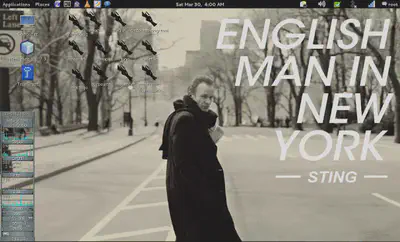
Kali Linux is a penetration testing and security auditing Linux distribution. After its release in March 2013, Kali Linux has quickly become the new favorite among PenTesters worldwide as their choice for the PenTesting OS. Replacing its predecessor Backtrack, Kali incorporated several new features and looks quite promising. It is available for i386 and amd64 architectures and has the same Minimum Hardware Requirements as Backtrack: 1 GHz CPU, 8 GB of Hard Disk Space, 300 MB RAM, And DVD-writer/Ability to boot with a Pen drive.
A Little History
To be very concise, Kali is an offshoot of Backtrack, which is an Offshoot of ‘Whax’, which is itself an Offshoot of ‘Whoppix’, which is derived from ‘Knoppix’. Something common among all of these distros is that they were focused on Digital Forensics and Intrusion Detection, with Backtrack and Kali adding a whole lot of Tools for PenTesting purposes. Backtrack has been “giving machine guns to monkeys since 2007”, so it has had a long reign as the favorite distro of PenTesters worldwide. ‘Offensive-Security’, the creators of Backtrack, decided to incorporate many changes in new Backtrack 6 (as it was called at that time). Since it was built from scratch, it was significantly different from the older versions of Backtrack and Offensive-Security decided to give a new name to the Distro – ‘Kali Linux’.
What was wrong with Backtrack and why it needed a change?
We all love Backtrack but bottom-line is that there are a lot of problems associated with this distro. The most annoying problem is ‘updating’. There was always a fear of ‘breaking’ something if you updated it. There were too many tools and some of them weren’t updated as frequently as the others. So updating the ‘dependencies’ of some would cause others to crash and we struggled to maintain a balance where all these tools and their dependencies would co-exist without getting in each other’s way.
When we wanted to use a tool, we needed to type the absolute path in shell.
For example, /pentest/passwords/john/john “file_name”
Remembering the locations of the tools was a pain and it just made things complicated.
In addition, Backtrack had a lot of ‘puny’ errors which crept up here and there while we were working, small issues that we had to resolve on our own or run to Backtrack forums and get help from other pentesters there.
For example, the wicd d-bus error that was ready to greet us when we installed a fresh copy of BT5 and tried to connect to a network. Backtrack forums (and other websites) are filled with ‘how-to posts’ that attempt to provide solution to such problems. Eventually we learned to get around these issues but it did waste a lot of our time.
What makes Kali different from Backtrack 5?
This is the most asked question about Kali today. Offensive Security has tried to answer it on their website:
“Unfortunately for us, that’s not a simple question to answer. It’s a mix between ‘everything’ and ‘not much’, depending on how you used Backtrack.”
Highlights of the new Kali
Switch From Ubuntu to Debian
Kali Linux is based on Debian (Debian Wheezy). This turned out to be a great move by Offensive-Security. The New Kali is much more comfortable to use than its predecessor.
File Hierarchy Standard Compliance
In the words of ‘MUTS’ from Offensive Security:
“What this means is that instead of having to navigate through the /pentest tree, you will be able to call any tool from anywhere on the system as every application is included in the system path."
This is again a very welcome change in Kali.
Customizations of Kali ISOs
If need be, we can now build our own customizations of Kali Linux. These ISOs can be bootstrapped directly from the repositories maintained by Offensive Security.
ARM Devices Support
Kali is available for the following ARM devices: rk3306 mk/ss808, Raspberry Pi, ODROID U2/X2, Samsung Chromebook, EfikaMX, Beaglebone Black, CuBox and Galaxy Note 10.1
Easier Updating and Upgrading
Packages on Kali can be updated with ease without worrying about ‘breaking’ something. This is because the packages in the Kali repositories are ‘Debian Compliant’. The Kali Distribution itself can be upgraded to newer version without the need for re-installing the distro.
300+ PenTesting Tools
This is quite a large collection and chances are that we won’t be needing all of them and we might be needing some that are not included by default. However packages can always be grabbed from the repositories at will, so that’s never a problem.
What is this ‘Forensics Mode’?
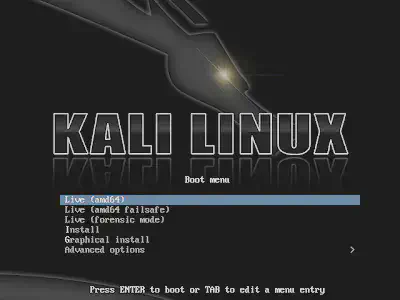
Figure 2: Kali Linux Boot Menu
While booting up Kali Linux, an option exists for ‘Live Forensic Mode’ (Figure 2). This is quite a useful feature if we want to do some real world forensic work. When into Forensics Mode, the internal Hard Disk is not touched in any manner. The People at Offensive Security Performed a Hash Comparison test where Hashes were taken of the Hard Drive before and after using Kali in forensics mode. At the end of the test, the hashes matched suggesting that no changes were made during the operation. Also worth noticing is that the Auto mount of Removable Media is disabled while in Forensics mode.
**Metasploit Framework in Kali **
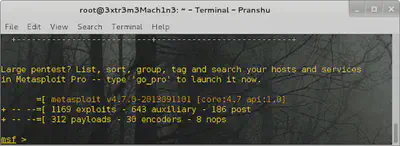
Figure 3: Metasploit Framework in Kali
The discussion on Kali (or Backtrack for that matter) would be incomplete without a mention of how well the Metasploit Framework is integrated with this distro. While msfconsole brings it up, msfupdate can update the metaspoit framework. Like in Backtrack, POSTGRESQL is used to store the database.
The guys from offensive security and rapid7 (people behind the metasploit project), co-operated to pre-load Kali Linux with msfpro (the professional web-service version of metasploit framework). Metasploit in Kali has full tech support from rapid7.
Tools in Kali Linux
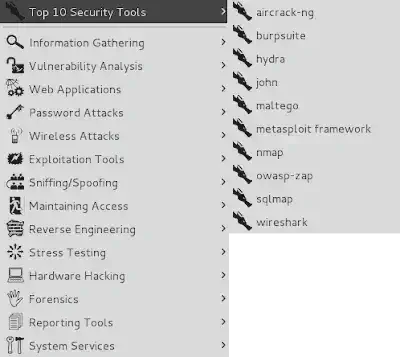
Figure 4: The Top 10 Security Tools in Kali
Tools are mostly the same as those found in Backtrack. However, in the Kali Linux menu, 10 Security tools have been highlighted as the Top 10 (Figure 4). Anyone who has worked on BT would have no trouble guessing which tools would be available on Kali and which need to be grabbed from the repositories. More than 300 tools come packaged with Kali which are enough to serve the needs of most PenTests. The Top 10 tools in Kali Linux are mentioned below:
· Aircrack-ng – For wireless Cracking
· Burpsuite – For Web Applications Pentesting
· Hydra – For online Brute-Forcing of Passwords
· John – For offline Password Cracking
· Maltego – For Intelligence Gathering
· Metasploit Framework – For Exploitation
· Nmap – For Network Scanning
· Owasp-zap - For finding vulnerabilities in web applications
· Sqlmap – For exploiting SQL injection Vulnerabilities
· Wireshark – Network Protocol Analyzer
Kali Community Support
Kali Linux has an official IRC Channel on the Freenode network, #kali-linux. It provides a good platform to interact with other users of Kali and get support.
Kali Linux provides three official repositories:
· http.kali.org: main package repository
· security.kali.org: security packages
· cdimage.kali.org: ISO images
Subtle differences noticed while regular work on Kali
One had to bring up the Graphical Interface manually by typind startx in Backtrack. However Kali loads up the Graphical User Interface by default.
Kali Linux environment is much cleaner and appears more stable than Backtrack 5
The Nessus Vulnerability scanner is not installed in Kali by default (as it was in Backtrack 5). You would have to install it manually from the debian package.
Kali comes with a Graphical Packages installer which can be used to install new packages with the click of the mouse. It can brought up by typing the command: gpk-application
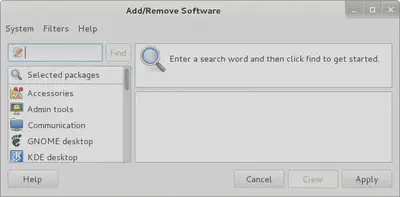
Figure 5: Graphical Package Installer in Kali
In Backtrack, several PenTesters faced issues in getting their Bluetooth up and running. The Backtrack forums are filled with people troubleshooting their Bluetooth devices. In Kali Linux no such problem was noticed and the Bluetooth works fine.
Firefox is replaced by Iceweasal which doesn’t matter much as they are both similar. However the Iceweasal Browser in Kali doesn’t come pre-loaded with plug-ins like no-script as in Firefox in Backtrack. Iceweasal comes clean.
Small issues like inability to control your backlight in Backtrack have been fixed in Kali Linux. So you would have a smoother working environment.
Summary
Kali Linux definitely turned out to be everything that a Penetration Tester would want from a Linux distro. It does have room for improvements though and the developers are working on it constantly to make it better. It addresses the problems Backtrack 5 had and it is significantly different from its predecessor, yet any PenTester who was comfortable using Backtrack 5 would find his way around in Kali Linux with ease. The default login in Kali Linux is in ‘root’ mode, so it is not the everyday desktop OS and is not recommended for those new to ‘Linux’. However it fits the Penetration Testing needs perfectly.
On the Web
www.kali.org - The main Kali Linux website
docs.kali.org - documentation site
forums.kali.org – Discussion Forums
bugs.kali.org – For reporting bugs
git.kali.org - monitor the development of Kali Linux
Here’s the Original Article Content, Before I Updated it:
Backtrack 5 or Kali Linux??
**What’s the Difference between Kali Linux and Backtrack 5 ? **
It’s hard to answer that. You have to use it and see for yourself.
But the most obvious is the shift from Ubuntu to Debian (which is a great move in my opinion). You’ll immediately feel the difference in the looks and feel of the new Kali Linux.

There are no puny errors like “Error connecting to wicd’s D-bus bla bla” when you try to fire up Wicd in Backtrack 5. Kali Linux is much more cleaner in these respect than Backtrack 5.
I feel Kali Linux is more stable than Backtrack 5. However, my Kali has hung up on a few occasions, but I’m guessing that’s because of some crappy package I installed because I keep trying out new packages on Kali.
In Kali, There’s no /pentest directory like in Backtrack 5. Personally, I don’t miss it and neither should you, because now you can fire up any tool just by typing it’s name in the shell.
They have removed Nessus Vulnerability Scanner in Kali, You can manually install it by downloading it from Tenable. However, I don’t understand why they removed it from default tools in kali, because I really liked scanning for Vulnerabilities in Nessus.
Kali Linux is Smaller in size than Backtrack 5 (which was around 3 GB if I remember correctly). Kali’s ISO is just 2 GB in size.
They’ve seperated “Top 10 Security Tools” in the Menu of Kali Linux which contains some much-hyped security tools.
Bluetooth works great on Kali Linux. I don’t know about you, but I faced a lot of trouble getting my bluetooth up in Backtrack 5 r3, really frustrating. But in Kali Linux, bluetooth works fine with a click of a mouse, which helps me pen test bluetooth devices with ease now.
VLC Player comes pre-installed with Kali linux. This was not the case with Backtrack 5 where you had to manually install it and then it gave you an error saying “Won’t run in root mode” and then you had to hex-edit the VLC binary. In Kali VLC is pre-installed (however I did notice some lag problems in VLC in Kali).
Firefox has been replaced by Iceweasal which is again a good move. They are both given by Mozilla and very similar. However like Firefox in Backtrack comes with noscript and such add-ons for security, Iceweasal in Kali comes clean.
That irritating light pdf viewer in Backtrack has been replaced by ‘Document Viewer’.
No ‘gedit’ in kali, instead you can use ‘Leafpad’
In Backtrack, there wasn’t a way to control your back-light. I remember searching for a way to control back-light but not finding it. It was set to Max by default. Very tiring for the eyes. No such problem in Kali Linux
That’s all for now, I’ll keep updating as I notice more.
(I didn’t go deep into ‘Tools’ much since they are mostly similar and if there’s anything missing, you can always install it from repositories)